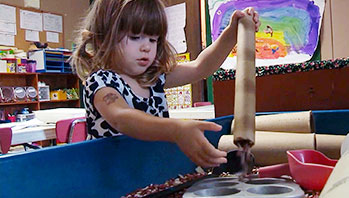- clear contact paper
- large sheet of poster board
- markers
- small items that will sink or float (balls, feathers, flower petals, metal and plastic bottle caps, paper clips, pieces of cork, crayons, pencils, small sponges, toy boats, keys, marbles, coins, wooden blocks, nails, balls of aluminum foil, plastic blocks, paper cups, plastic cups)
- water
- water table
- writing materials
- packaging tape
- absorb
- float
- sink
- water
MA Standards:
Language/L.PK.MA.5.a: Demonstrate understanding of concepts by sorting common objects into categories (e.g., sort objects by color, shape, or texture).
Mathematics/Counting and Cardinality/PK.CC.MA.5: Use comparative language, such as more/less, equal to, to compare and describe collections of objects.
MA Draft STE Standards:
Physical Sciences/Matter and Its Interactions: Structure and Properties of Matter/PS1.A: Describe, compare, sort and classify objects based on observable physical characteristics, uses, and whether it is manufactured as part of their classroom play and investigations of the natural and human-made world.
Head Start Outcomes:
Logic and Reasoning/Reasoning and Problem Solving: Classifies, compares, and contrasts objects, events, and experiences.
Science Knowledge/Scientific Skills and Method: Observes and discusses common properties, differences, and comparisons among objects.
PreK Learning Guidelines:
Mathematics/Patterns and Relations 8: Sort, categorize, or classify objects by more than one attribute.
Does It Float?

© Commonwealth of Massachusetts, Department of Early Education and Care. All rights reserved.
Skill Focus: Compare and Contrast, Fine Motor Skills, Predicting, Vocabulary
Educator Prep: Before the activity, draw a curved horizontal line across the middle of the poster board to look like a wave. Label the space above the wave “Float” and the space below “Sink.” Cover the chart with contact paper to make it waterproof, and place on the floor by the water table. Precut strips of packaging and hang them so children can just grab an end to use.
Tell children they are going to create a chart that shows what things float and what things sink. Point to the chart and tell children it has plastic over it so it will not absorb water. Explain that you want them to test objects to see what floats and sinks, then you want them to tape each one to the correct side of the chart. First they will make predictions.
- Select one of the objects and ask children if they think it will float and why they think so.
- Ask a child to place the object in the water.
- Ask, Does the object float or sink? Was that what we thought it would do?
- Have the child place the object in the “Sink” or “Float” half of the chart, depending on how it behaved.
- Repeat with the remaining items.
- Encourage children to experiment with the materials on their own.
As children explore, prompt them to describe what they are doing and what they observe. Point out that sometimes small things (like paperclips and pennies) sink while sometimes big things (like large wooden blocks) float.
Adaptation: For groups with very young children, you want to be sure none of the float and sink items are small enough for them to swallow. You may want to use things such as craft sticks, cubes, feathers, sponges, etc.
